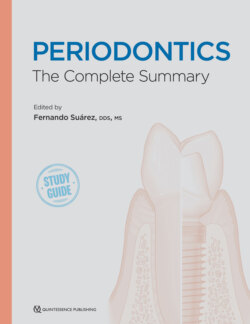Читать книгу Periodontics - Fernando Suarez - Страница 87
Biofilm and Calculus
ОглавлениеBiofilm formation is a progressive and dynamic process that facilitates bacterial attachment to tooth structures through van der Waals forces, glycocalyx, and lectin-like receptors within a salivary pellicle and negative surface charges mediated by teichoic acid of gram-positive bacteria.14–16 The shift from gram-positive to gram-negative bacteria occurs as subgingival plaque develops and is influenced by biofilm thickness and gingival crevicular fluid. The process of mineralization of biofilm into dental calculus has been suggested by Genco et al16 to undergo four theoretical processes: booster mechanism, epitaxic concept, inhibition theory, and transformation theory.
The inorganic and organic composition of dental calculus have been extensively explored.17–28 Major inorganic components of dental calculus are calcium, phosphorus, carbonate, sodium, magnesium, potassium, and trace elements such as fluoride and zinc.16 Moreover, four major crystalline forms can be noted within mature calculus, including hydroxyapatite, octacalcium phosphate (OCP), whitlockite (WHT), and brushite.18,20,22 On the other hand, proteins (50%–60%), carbohydrates (12%–20%), and lipids (10%–15%) represent about 15% to 20% of the dry weight of mature supragingival plaque.29 Major differences in the characteristics of dental calculus exist depending on the location. Table 5-1 summarizes the characteristics of both supragingival and subgingival calculus.30
TABLE 5-1 Characteristics of supragingival and subgingival calculus*
| Supragingival | Subgingival | |
| Location | Coronal to gingival margin | Apical to gingival margin |
| Color | Yellow/white | Brown/black |
| Distribution | Adjacent to salivary duct openings | Randomly around the oral cavity |
| Composition | Low concentration of Ca, Mg, F, Sr, and ZnHigh concentration of carbonate and Mn | High concentration of Ca, Mg, and FLower concentration of carbonateMore irregular distribution of F |
| Mineral content and source | Average of 37% from saliva by volume | Average of 58% from gingival crevicular fluid by volume |
| Crystal type | Mostly OCP and hydroxyapatite | Mostly WHT |
| Formation | Heterogenous nucleation and crystal growthMore variable calcification | Heterogenous nucleation and crystal growthMore homogenous calcification |
| Microorganisms | More filamentous, faster growing | Less filamentous, slower growing |
| Morphology | Heterogenous with small needle-shaped (100 nm), large-ribbon-like and bundle/rosettes (1–50 nm) crystals | Several crystal types (< 50 nm): spiny, crusty, nodular, ledge/ring, individual islands, smooth veneers and finger/fern-like |
| Pathogenic potential | Little evidence | Associated with periodontal disease |
*Adapted and modified from Roberts-Harry and Clerehugh.30
Ca, calcium; Mg, magnesium; F, fluoride; Sr, strontium; Zn, zinc; Mn, manganese; Na, sodium.
